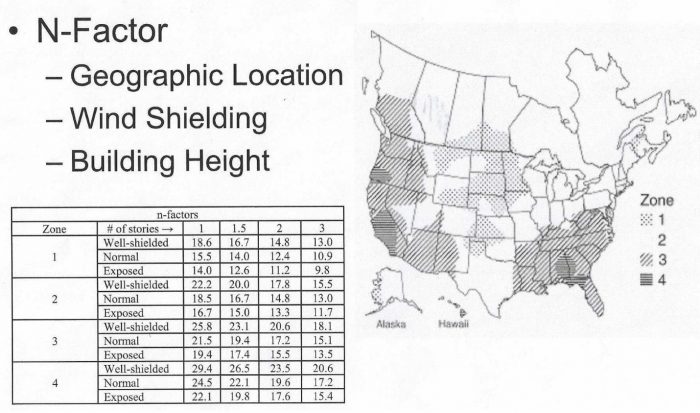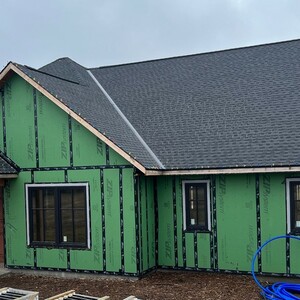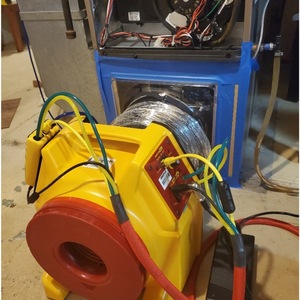
When conducting a blower door test, one of the ways we express the findings is with air changes per hour at 50 Pascals (ACH50). As an example, a new home is blower door tested and found to be 2.75 ACH50, this means the entire volume of air inside the home is exchanging with the outside air 2.75 time per hour at the test pressure of 50 Pascals. When discussing blower door testing with builders and homeowners, it can be hard for them to relate to the ACH50 number other than they know the home needs to be less than a certain level of air tightness to meet current code requirements. Expressing the tightness as natural air leakage can sometimes be helpful. How can we calculate the natural air change rate? Well, there’s a formula:
ACH50/n-Factor = ACHnat
Easy enough formula, but what is n-Factor? The n-Factor (also called the LBL Factor) was developed a few decades ago by the Lawrence Berkeley Laboratory (LBL) as a way to calculate the natural air change rate by using the blower door test results. They came up with a map of the U.S. and Canada that uses wind data for the given location, how well shielded the home is, and how many stories the home has. The illustration and chart are used to determine the n-Factor for a given area.

Using the area I where live as an example, the arrowhead of Minnesota, the zone two portion of the table would be used. Next you would have to determine the shielding of the home. I haven’t seen a lot of information on what the parameters are for a well-shielded home compared to an exposed home, so I use the well shielded table when the home is surrounded by a dense woodland or tall buildings. The exposed…
Weekly Newsletter
Get building science and energy efficiency advice, plus special offers, in your inbox.

This article is only available to GBA Prime Members
Sign up for a free trial and get instant access to this article as well as GBA’s complete library of premium articles and construction details.
Start Free TrialAlready a member? Log in















3 Comments
Randy,
Compared to the existing housing stock in MN, the 2.75 ACH50 for your example home is quite airtight, it took some work to get there. My guess is the average MN home is somewhere over 5 ACH50 before weatherization. With the current high energy costs, air sealing is money well spent.
Thanks, Doug
Thanks, Randy. The calculation I'm thinking would be helpful is converting measured leakage, in CFM50, to design leakage under design conditions. We're in a generations-old cold war battle with HVAC contractors and specifiers over the significance of building leakage in driving design loads. While on the one hand they often assume buildings are above-average leaky for the purposes of load calculations, on the other hand they also believe building leakage is essentially unknowable and having a more accurate number isn't significant for the load calculation.
After decades of very successful new construction- and weatherization programs the likelihood that any given building around here has had a leakage test is very high. Our energy code even requires leakage testing as of 2020. It's high time we bring correct leakage characterization and load calculations together. No one wants to do bad work, but there needs to be credible way for the energy folks to talk to the power folks before long-standing practice will change.
Randy, thanks for a thorough overview! I remember trying to find information on natural air changes years ago and having to piece together information from various sources, so it's great to have it all in one, trustworthy place.
Log in or become a member to post a comment.
Sign up Log in